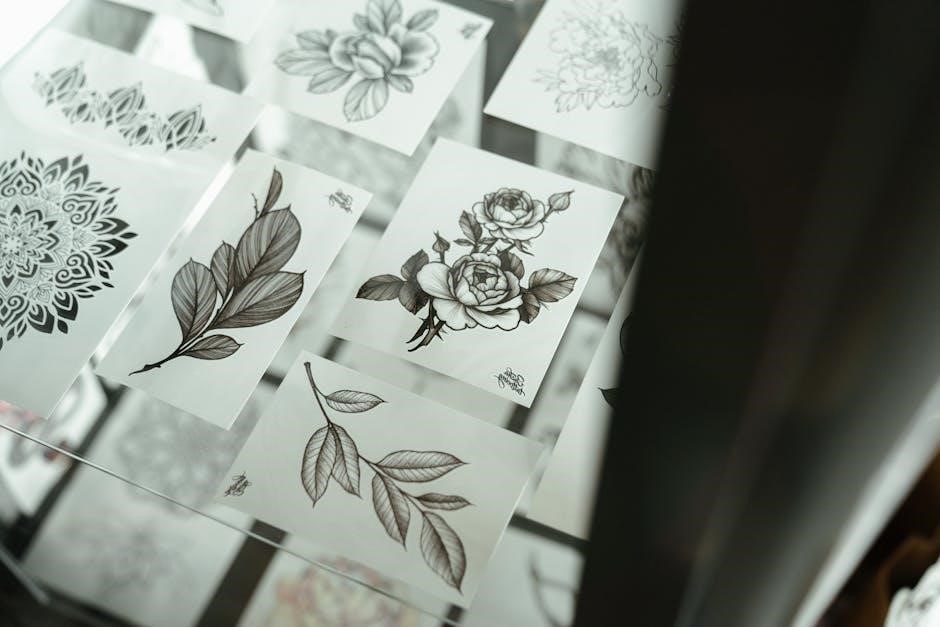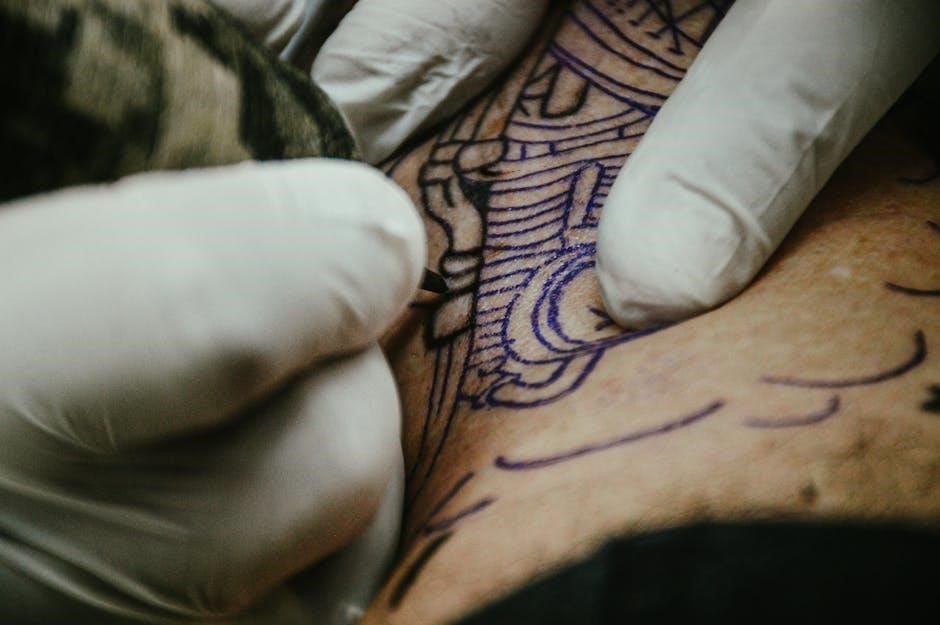Tattooing is a form of artistic expression, creating permanent designs on the skin. It requires careful consideration, quality tools, and practice. Research, patience, and expert guidance are essential for beginners to ensure a safe and satisfying experience.
What is Tattooing?
Tattooing is the art of creating permanent designs on the skin by inserting ink into the dermis layer. It involves using a tattoo machine with needles to puncture the skin and deposit pigment. This process allows for intricate designs, ranging from simple lines to complex, colorful artwork. Tattooing is a form of self-expression and has been practiced across various cultures for centuries. While it is permanent, advancements in techniques and tools have made it safer and more accessible. For beginners, understanding the basics of tattooing is crucial to appreciate its artistry and challenges.
Why People Get Tattoos
People choose to get tattoos for various personal reasons, often tied to self-expression. Tattoos can symbolize meaningful experiences, memories, or cultural heritage. They also serve as a form of artistic expression, allowing individuals to showcase their unique style. Many find tattoos empowering, as they provide a permanent way to celebrate identity or overcome challenges. Some seek tattoos for spiritual or emotional reasons, while others simply enjoy the aesthetic appeal. Regardless of the motivation, tattoos offer a lasting way to convey personal stories and values, making them a significant and intimate form of art.
The Importance of Research Before Getting a Tattoo
Research is crucial before getting a tattoo to ensure a positive experience. It helps you understand the process, risks, and aftercare. Investigating reputable artists and studios ensures safety and quality. Learning about different styles and techniques allows you to make informed decisions. Understanding the pain levels and preparation needed can reduce anxiety. Researching also helps you find designs that truly reflect your identity. Additionally, knowing the cost, time, and long-term maintenance is essential. Proper research prevents regrets and ensures your tattoo is both meaningful and well-executed; It’s a lifelong commitment, so taking the time to gather information is vital for satisfaction.

Choosing the Right Equipment
Choosing the right equipment is vital for safe tattooing. Invest in high-quality machines, sterile needles, professional ink, and proper aftercare products for optimal results and maintaining.
What You Need to Start Tattooing
To begin tattooing, you’ll need a tattoo machine, sterile needles, high-quality ink, and a power supply. Ensure you have disposable gloves, hygiene supplies, and aftercare products. Practice on fake skin or pigskin before working on real skin. A stencil machine and stencil paper are essential for transferring designs accurately. Invest in a tattoo kit designed for beginners, which typically includes everything you need to get started. Always prioritize safety and sterility to prevent infections and ensure professional results. Research and understand the equipment thoroughly before use, and consider seeking guidance from experienced artists to avoid common mistakes.
Understanding Tattoo Machines
Tattoo machines are the heart of tattooing, delivering ink into the skin through a needle. They come in two types: rotary and coil. Rotary machines are quieter, easier to handle, and suitable for beginners. Coil machines are traditional, offering more control but requiring more skill. Both types require proper setup and tuning. The machine’s speed and needle depth are crucial for achieving desired effects. Regular maintenance, including replacing worn parts and ensuring proper lubrication, is essential for optimal performance. Understanding how to adjust and care for your machine will improve your tattooing skills and ensure consistent results. Always follow manufacturer guidelines to maintain the machine’s efficiency and longevity.
The Role of Needles in Tattooing
Needles are a critical component in tattooing, determining the quality and detail of the design. Different needle types, such as liners, shaders, and magnums, serve specific purposes. Liner needles create precise lines and outlines, while shaders and magnums are used for shading, coloring, and filling large areas. The needle’s size and configuration directly impact the outcome, making it essential to choose the right type for each part of the tattoo. Proper needle maintenance, including sterilization and safe usage, is vital to prevent health risks. Understanding how to handle and replace needles ensures a hygienic and professional tattooing process. Their role is indispensable in achieving the desired artistic and technical results in tattooing.
Choosing the Right Ink
Choosing the right ink is crucial for achieving vibrant, long-lasting results in tattooing. High-quality tattoo ink ensures better color retention and reduces the risk of allergic reactions. Beginners should opt for reputable brands that adhere to safety standards and use non-toxic, light-fast pigments. Different ink types, such as vegan or hypoallergenic options, cater to specific needs. It’s important to research and understand the ingredients to avoid harmful chemicals. Consulting with experienced artists can help guide the selection process. Proper ink storage and hygiene practices are also essential to maintain the ink’s quality and prevent contamination. Selecting the right ink not only enhances the tattoo’s appearance but also ensures a safer and more professional experience for both the artist and the client.

Basic Tattooing Techniques
Mastering basic techniques is essential for beginners. Start with proper machine handling, steady hand movement, and consistent needle depth. Practice on fake skin to build confidence and precision before working on real skin.
How to Use a Tattoo Machine
Using a tattoo machine requires precision and control. Hold it firmly but not too tightly, with a steady hand. Adjust the machine’s voltage and needle depth according to the technique—lining or shading. Practice on fake skin to understand how the needles interact with the surface. Start with low speed for lines and increase for shading. Keep the machine perpendicular to the skin to avoid uneven ink distribution. Clean and maintain the equipment regularly for optimal performance. Always follow safety and hygiene practices to prevent infections. Guided practice with an experienced artist is recommended to master the technique effectively;

Creating Stencils for Tattoos
Creating stencils is a crucial step in tattooing, ensuring precision and accuracy. Use high-quality stencil paper and a thermal copier or tracing tools to replicate the design; Apply a thin layer of stencil solution or deodorant to the paper, then transfer the design onto the skin. Ensure the stencil is clear and properly aligned before starting the tattoo. Practice drawing and transferring designs on fake skin to improve accuracy. Stencils help maintain consistency and allow for minor adjustments. They are especially useful for intricate designs and lining work. Proper stencil creation minimizes errors and enhances the overall tattoo quality.
Mastering Line Work
Mastering line work is fundamental to tattooing, requiring patience and precision. Start by practicing on fake skin or paper to build control and consistency. Use the right needles, such as liners, to achieve clean lines. Apply steady, smooth strokes, maintaining consistent pressure and speed. Focus on varying line thickness and spacing to add depth and detail. Study the work of experienced artists and replicate their techniques. Regular practice helps develop muscle memory and improves accuracy. Pay attention to the machine setup to ensure proper function. As you progress, experiment with different line styles, from fine details to bold outlines, to enhance your skills and create visually striking designs. Mastering line work is the foundation for all other tattooing techniques.
Shading Techniques
Shading is a crucial skill in tattooing, adding depth and dimension to designs. Start by understanding how needle depth and machine speed affect shading. Use magnums or shaders for broader areas and liners for details. Practice basic techniques like gradient shading and stippling on fake skin. Learn to transition smoothly between light and dark tones to create natural-looking shadows. Study how professional artists achieve soft blends and sharp contrasts. Regular practice helps refine your touch and consistency. Pay attention to the angle of the needle to avoid damaging the skin. As you progress, experiment with advanced shading methods to enhance your designs. Remember, shading requires patience and a steady hand, making it a key area to master for realistic and visually appealing tattoos.

Coloring and Filling
Coloring and filling are essential steps in creating vibrant, detailed tattoos. Start by selecting high-quality ink that suits your design. Use magnum needles for large areas and round liners for fine details. Apply steady, even pressure to ensure consistent color saturation. Begin with the darkest colors first, gradually transitioning to lighter shades to avoid muddying the ink. Practice color blending on fake skin to achieve smooth transitions. Pay attention to the machine’s speed and needle depth to prevent overworking the skin. Proper aftercare is crucial for maintaining color intensity. Study professional techniques for seamless color integration and depth. Regular practice will improve your ability to fill and color effectively, bringing your designs to life with precision and vibrancy.

Design Considerations
Design choice is crucial, reflecting personal style and meaning. Research styles like traditional, realism, and minimalist. Consider size, placement, and symbolism to ensure a tattoo that resonates personally and aesthetically.
Choosing the Right Tattoo Design
Selecting the right tattoo design is a personal journey that requires deep reflection. Consider your lifestyle, preferences, and the message you want to convey. Traditional, minimalist, or realistic styles are popular choices. Research artists and their portfolios to find designs that resonate with you. Think about symbolism, size, and placement to ensure the tattoo complements your body. It’s important to choose a design that holds meaning and brings satisfaction for years to come. Patience and careful consideration will lead to a tattoo that truly represents your identity and personal style.
Understanding Tattoo Styles
Exploring various tattoo styles helps beginners find their aesthetic preference. Traditional tattoos feature bold lines and vibrant colors, while minimalist designs emphasize simplicity with delicate lines. Realism focuses on highly detailed, lifelike imagery. Other styles include neo-traditional, which blends classic elements with modern twists, and abstract, which offers creative freedom. Each style has unique characteristics, making it essential to study and understand them before committing to a design. By researching and identifying personal preferences, individuals can choose a style that aligns with their vision. This step ensures satisfaction and a meaningful connection to the final artwork. Understanding these styles is crucial for making informed decisions.
Customizing Your Tattoo Design
![]()
Customizing a tattoo design allows for personalization, ensuring the artwork reflects individuality. Beginners should consider integrating personal symbols, meaningful dates, or cultural elements. Collaboration with an artist is key to refining ideas. Sketching and revising concepts helps achieve the desired look. Choosing colors that resonate emotionally enhances the design. Incorporating personal stories or memories adds depth. It’s important to communicate clearly with the artist to avoid misunderstandings. Taking time to perfect the design ensures long-term satisfaction. This process makes the tattoo uniquely significant and emotionally impactful. Customization transforms a design into a meaningful, lasting piece of body art.
Placement of Tattoos
Choosing where to place a tattoo is crucial for both aesthetic and practical reasons. Visibility and personal preference are key factors. Popular spots include arms, legs, and back, offering flexibility in design size. Small designs suit wrists or ankles, while larger pieces thrive on the chest or sleeves. Consider how the tattoo will look with various body movements. Placement also affects pain levels, with bony areas being more sensitive. Professional advice can help determine the best location for a desired design. Placement decisions should align with lifestyle, career, and personal comfort. This ensures the tattoo complements the body and meets individual goals. Thoughtful placement enhances the tattoo’s appeal and significance.

Preparing for Your First Tattoo
Research, stay calm, and choose a reputable artist. Prepare mentally and physically, ensuring good hygiene. Bring references and avoid alcohol. Stay hydrated and dress comfortably for the session.
Mental Preparation
Mental preparation is crucial before getting your first tattoo. It’s important to stay calm and focused to ensure a smooth experience. Researching the process thoroughly can help alleviate anxiety. Understanding the pain involved and setting realistic expectations is key. Beginners should also consider the emotional commitment, as tattoos are permanent. Practicing relaxation techniques, such as deep breathing, can help manage nerves. Additionally, having a clear idea of the design and its meaning can boost confidence. Avoid making impulsive decisions and take time to reflect on your choices. A well-prepared mindset will make the tattooing process more enjoyable and satisfying in the long run.
Physical Preparation
Physical preparation is vital to ensure a comfortable and safe tattooing experience. Start by maintaining good health through proper nutrition and adequate rest. Avoid alcohol and caffeine before your session, as they can thin your blood and affect the process. Stay hydrated to keep your skin healthy and receptive. Wear comfortable clothing that allows easy access to the area being tattooed. Bring snacks or energy bars to keep your energy levels steady during long sessions. Plan for regular breaks to stretch and move around. A well-prepared body will handle the tattooing process more effectively, reducing discomfort and stress. Ensuring physical readiness contributes to a positive overall experience.
Choosing the Right Tattoo Artist
Selecting the right tattoo artist is a critical step for beginners. Look for an artist with extensive experience and a portfolio that aligns with your desired style. Ensure they use sterile equipment and follow proper hygiene practices to minimize health risks. Visit the studio in person to assess cleanliness and professionalism. Communication is key—discuss your design ideas and expectations openly. A reputable artist will guide you through the process, offer advice, and ensure you’re comfortable. Check online reviews and ask for recommendations to find a trustworthy artist. Building a connection with your artist will enhance your tattooing experience and result in a design you’ll love. Prioritize quality and reliability when making your choice.

Aftercare and Maintenance
Proper aftercare ensures tattoo healing and longevity. Keep it clean, moisturized, and avoid direct sun. Monitor for infections and maintain hydration for vibrant, lasting results.
Proper Aftercare for a New Tattoo
Proper aftercare is crucial for healing and maintaining your new tattoo. Keep the tattoo clean with mild soap and lukewarm water daily. Avoid submerging it in water until fully healed. Use a fragrance-free, non-comedogenic moisturizer to prevent dryness and irritation. Avoid direct sunlight and tight clothing that may cause friction. Monitor for signs of infection, such as redness, swelling, or pus. Maintain a consistent skincare routine to ensure the tattoo heals smoothly and retains its vibrant colors. Proper aftercare not only promotes healing but also preserves the quality of your tattoo for years to come.
Common Mistakes to Avoid
When starting with tattooing, several mistakes can hinder progress. Rushing into tattooing without proper practice is a common error, leading to poor results. Neglecting to invest in quality equipment can compromise safety and artistry. Skipping the stencil stage often results in misaligned designs. Overlooking proper sanitation and hygiene increases the risk of infections. Additionally, not seeking guidance from experienced artists can lead to unnecessary challenges. Avoiding these pitfalls ensures a smoother journey and better outcomes for beginners. Consistent practice and adherence to professional advice are key to mastering tattooing techniques and achieving satisfying results. Patience and dedication are essential in this artistic process.
Maintaining Your Tattoo
Maintaining your tattoo ensures its longevity and vibrant appearance. Proper aftercare is crucial, involving regular cleaning with mild soap and moisturizing to prevent dryness. Direct sunlight should be avoided as UV rays can cause fading. Touch-ups may be needed post-healing to perfect the design. Keep the tattoo away from water until fully healed to minimize infection risks. Sun protection is vital long-term to preserve colors. Avoid picking at scabs, as this can damage the tattoo. A balanced diet and hydration support skin health, promoting better ink retention. Regular moisturizing keeps the skin hydrated and the tattoo looking fresh. Following these care tips ensures your tattoo remains a stunning piece of art for years to come.

Advanced Tips and Tricks
Master advanced techniques like realistic designs, shading, and color blending. Experiment with needle configurations for unique effects. Practice consistently and study professional work to refine your skills.
How to Create Realistic Tattoos
Creating realistic tattoos involves meticulous attention to detail and understanding light and shadow. Start by studying reference images to capture accurate proportions and textures. Use fine needles for intricate details and gradually build depth with shading techniques. Practice on synthetic skin or pigskin before working on real skin. Pay attention to color theory to achieve lifelike hues. Watch tutorials and seek guidance from experienced artists to refine your skills. Consistent practice and patience are key to mastering realistic tattooing.
Using Different Needles for Different Effects
Different tattoo needles create distinct effects, making them essential for achieving desired outcomes. Liner needles are ideal for outlines and fine details, while shader needles are used for shading and coloring. Magnum needles are best for bold lines and filling large areas. Each needle type varies in configuration, affecting ink flow and detail precision. Proper needle selection enhances design clarity and ensures smooth application. Understanding their roles helps beginners master various techniques, from delicate linework to vibrant color fills. Experimenting with different needles on practice skins helps develop skill and confidence in creating diverse tattoo effects.
Advanced Shading Techniques
Advanced shading techniques elevate tattoo artistry by creating depth and dimension. Gradation involves blending colors smoothly, while contrast enhances visual impact. Stippling uses dots for texture, and feathering softens edges. These methods require precise control and practice. Layers and transitions are key for realism. Investing time in mastering these skills ensures professional-quality results, making tattoos more dynamic and visually striking.
Tattooing for beginners requires dedication, patience, and practice. Start with proper tools, seek expert advice, and refine your skills gradually. Persistence leads to mastery and beautiful artistry.
Final Thoughts on Tattooing for Beginners
Tattooing for beginners is an exciting yet challenging journey. It requires research, patience, and dedication to master the craft. Always start with quality equipment and practice on fake skin or paper before working on real skin. Seek guidance from experienced artists and build your skills gradually. Remember, tattooing is not just about art—it’s about safety, precision, and understanding your tools. Stay committed, embrace feedback, and enjoy the process of creating something meaningful. With persistence and passion, you’ll grow into a skilled tattoo artist. Always prioritize proper aftercare and maintain a professional mindset to ensure the best results for yourself and your clients.
